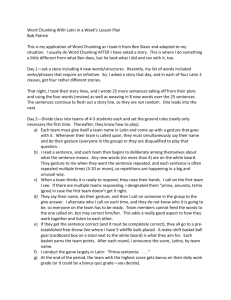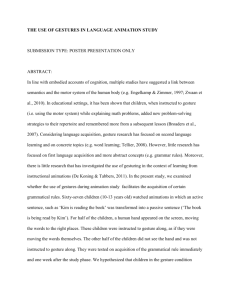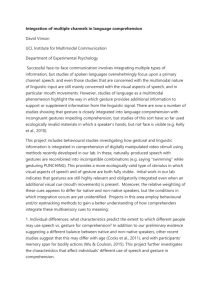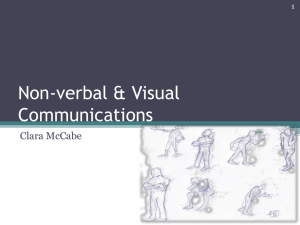15 January 1998
advertisement
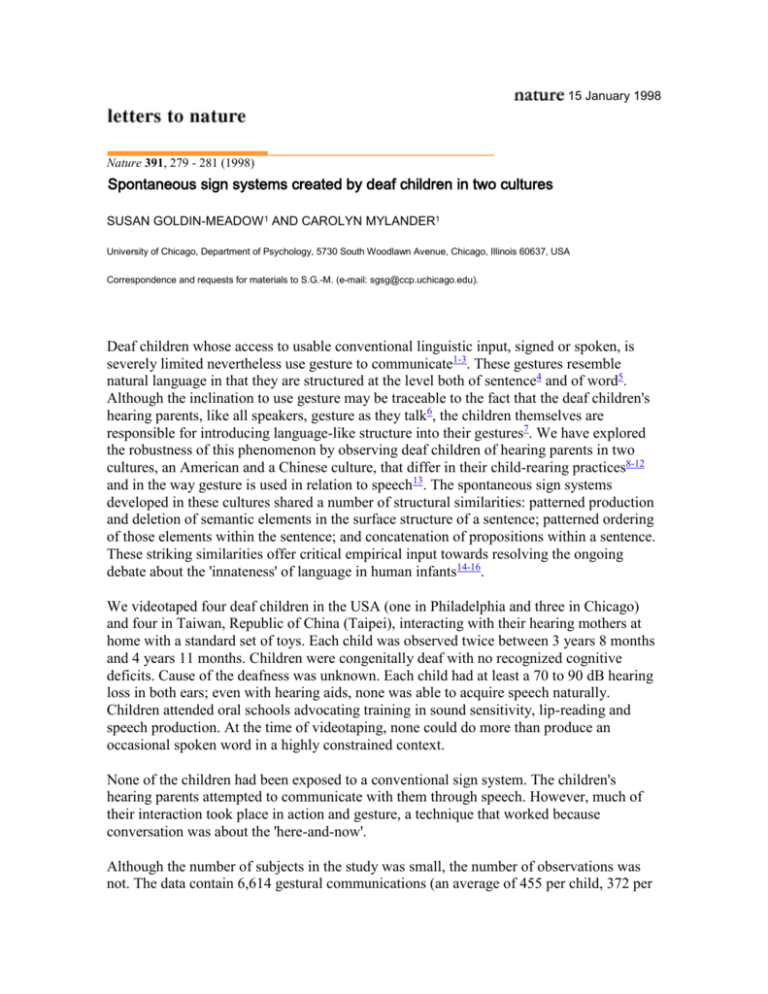
15 January 1998
Nature 391, 279 - 281 (1998)
Spontaneous sign systems created by deaf children in two cultures
SUSAN GOLDIN-MEADOW 1 AND CAROLYN MYLANDER1
University of Chicago, Department of Psychology, 5730 South Woodlawn Avenue, Chicago, Illinois 60637, USA
Correspondence and requests for materials to S.G.-M. (e-mail: sgsg@ccp.uchicago.edu).
Deaf children whose access to usable conventional linguistic input, signed or spoken, is
severely limited nevertheless use gesture to communicate1-3. These gestures resemble
natural language in that they are structured at the level both of sentence4 and of word5.
Although the inclination to use gesture may be traceable to the fact that the deaf children's
hearing parents, like all speakers, gesture as they talk6, the children themselves are
responsible for introducing language-like structure into their gestures7. We have explored
the robustness of this phenomenon by observing deaf children of hearing parents in two
cultures, an American and a Chinese culture, that differ in their child-rearing practices8-12
and in the way gesture is used in relation to speech13. The spontaneous sign systems
developed in these cultures shared a number of structural similarities: patterned production
and deletion of semantic elements in the surface structure of a sentence; patterned ordering
of those elements within the sentence; and concatenation of propositions within a sentence.
These striking similarities offer critical empirical input towards resolving the ongoing
debate about the 'innateness' of language in human infants14-16.
We videotaped four deaf children in the USA (one in Philadelphia and three in Chicago)
and four in Taiwan, Republic of China (Taipei), interacting with their hearing mothers at
home with a standard set of toys. Each child was observed twice between 3 years 8 months
and 4 years 11 months. Children were congenitally deaf with no recognized cognitive
deficits. Cause of the deafness was unknown. Each child had at least a 70 to 90 dB hearing
loss in both ears; even with hearing aids, none was able to acquire speech naturally.
Children attended oral schools advocating training in sound sensitivity, lip-reading and
speech production. At the time of videotaping, none could do more than produce an
occasional spoken word in a highly constrained context.
None of the children had been exposed to a conventional sign system. The children's
hearing parents attempted to communicate with them through speech. However, much of
their interaction took place in action and gesture, a technique that worked because
conversation was about the 'here-and-now'.
Although the number of subjects in the study was small, the number of observations was
not. The data contain 6,614 gestural communications (an average of 455 per child, 372 per
mother) made up of 10,398 individual gestures (779 per child, 531 per mother).
Unlike hearing children and adults who rarely concatenate their spontaneous gestures into
strings17,18 the deaf children in both cultures often conveyed their message through gesture
sentences rather than single gestures. The sentences the Chinese and American children
produced conformed closely to a structural analogue of the ergative pattern that
predominates in some, but not all, natural languages19,20; importantly, not in English or
Mandarin. This observation reduces the likelihood that the grammatical structure noted in
the deaf children's gesture systems was somehow derived from the structure of the spoken
languages that surrounded them.
The hallmark of an ergative pattern is that the actor in an intransitive sentence (mouse in
the proposition 'mouse goes to hole') is distinguished linguistically from the actor in a
transitive sentence (mouse in 'mouse eats cheese') and instead is marked like the patient
(cheese). In contrast, in English, which is predominantly an accusative language,
intransitive actors are treated like transitive actors and not like patients; for example, both
actors precede the verb ('the mousegoes to the hole' and 'the mouseeats the cheese') whereas
patients follow the verb ('the mouse eats the cheese').
Children in both cultures produced gestures for transitive actors, patients and intransitive
actors at different rates (Fig. 1, dark bars; F(2,7) = 22.52, P < 0.0001 for the groups
combined; proportional data subjected to Freeman–Tukey transform before statistical
analysis21). Gestures were produced significantly more often for patients (eaten-cheese) and
for intransitive actors (moving-mouse) than for transitive actors (eating-mouse; both
comparisons P < 0.01, Newman–Keuls). There were no significant differences between
patients and intransitive actors. This production probability conformed to an ergative
pattern: gesture production was high and equal for intransitive actors and patients, and low
for transitive actors. Note that production probability patterns convey information about
who is the doer and the done-to in two-element sentences. If, for example, a deaf child
produced the gesture sentence 'boy hit', it is likely that the boy was the hittee (patient)
rather than the hitter (transitive actor) in the scene under description.
Figure 1 Probability that a gesture will be produced for transitive
actors (TA), patients (P), and intransitive actors (IA) in a twoelement gesture sentence. Full legend
High resolution image and legend (72k)
In addition to producing reliably some semantic elements at the expense of others, children
were also consistent in where those elements were positioned in two-gesture strings.
Children in both cultures produced gestures for intransitive actors before gestures for acts
(mouse-go); Ling produced 14 of 15 relevant sentences conforming to this pattern, Qing 17
of 19, Bao 12 of 15, David 18 of 23, Abe 10 of 10 (P values 0.02; binomial test on each
child), Marvin 4 of 4, Karen 2 of 3 (Fen was an exception, 1 of 4). Children also produced
gestures for patients before gestures for acts (cheese-eat); Ling 11 of 12, Bao 26 of 29, Fen
9 of 11, Qing 29 of 29, Marvin 9 of 10 (P values 0.03), Abe 9 of 14, Karen 4 of 4 (David
was an exception, 17 of 35; the precocious onset of a noun/verb distinction may have
perturbed this pattern which was evident in his earlier sessions22). Thus, children in both
cultures placed intransitive actors in the same position as patients, a pattern again consistent
with an ergative structure.
Only two children, Qing and David, produced gestures for transitive actors often enough
for order to be explored. David produced gestures for transitive actors after gestures for acts
(eat-mouse, 5 of 6; this order has been confirmed in larger samples23). David thus
distinguished transitive from intransitive actors, not only in production probability, but also
in gesture order. Qing produced gestures for transitive actors in the same position as
intransitive actors and patients: before gestures for acts (mouse-eat, 8 of 8, P 0.004).
However, Qing did distinguish between patients and transitive actors when the two
appeared in the same string, producing gestures for transitive actors in second position after
patients (cheese-mouse, 6 of 7, P 0.06). Patients and intransitive actors thus consistently
occupied first position in two-element sentences, again conforming to an ergative structure.
Children in both cultures produced complex sentences, concatenating more than one
proposition within a single string. For example, one child produced a 'clap' gesture, a point
at himself, a 'twist' gesture, a 'blow' gesture, and a point at mother to request mother to twist
open the jar (proposition1) and blow a bubble (proposition2) so that he could clap it
(proposition3). The children did not differ significantly in their production of complex
sentences (U = 5, NS, Mann–Whitney U Test24; Fen 0.54 of 65 gesture sentences; Bao 0.42
of 289; Qing 0.41 of 257; Ling 0.33 of 156; David 0.45 of 394; Abe 0.36 of 152; Karen
0.34 of 50; Marvin 0.32 of 82). Each child's gesture system thus demonstrated generative
capability, an essential property of all natural languages.
We next explored a potential source of input to the children's gesture systems, analysing the
spontaneous gestures produced by the hearing mothers when interacting with their children
during these videotaped sessions. Like their children, mothers produced transitive actors,
patients, and intransitive actors at significantly different rates (Fig. 1, white bars; F(2,6) =
4.20, P < 0.05). Karen's mother produced no relevant intransitive sentences and was
consequently excluded from statistical analysis (n = 7); all other blank entries in the figure
reflect the fact that the mothers did not produce a semantic element when they had the
opportunity to do so (on average, they had 17.3 such opportunities). Mothers produced
more gestures for patients than for transitive actors (P < 0.05), thus distinguishing between
the two, as did their children. It is, however, where intransitive actors are situated relative
to transitive actors and patients that determines the typology of a language, and here
mothers and children differed. Mothers showed no reliable patterning of intransitive actors,
whereas children produced intransitive actors at a rate significantly different from transitive
actors but not different from patients, thus displaying an ergative pattern.
Chinese mothers tended to order their gestures within sentences in the same way as their
children (patient-act, mothers Bao 16 of 21, Fen 14 of 16, Ling 11 of 11, P values <0.01;
intransitive actor-act, mothers Bao 5 of 5, Fen 7 of 7, Qing 6 of 6, P values <0.02, Ling 9 of
12, P < 0.07), with the exception that Qing's mother showed no patient-act order (6 of 12)
and no patient-transitive actor order (2 of 5) although her child did. In contrast, American
mothers each produced only 2 to 5 relevant gesture sentences in these sessions, and more
extensive analyses of additional sessions23 also failed to reveal statistically significant
ordering patterns.
Across the two cultures, mothers produced proportionally fewer complex sentences than
their children (t(7) = 2.50, P < 0.05 on transformed data21; Fig. 2; total n = 1,445 children,
629 mothers), although the gap was much wider for American dyads than for Chinese. To
explore who took the lead in the production of complex gesture sentences, we looked at the
developmental pattern for American mothers and children in additional videotaped sessions
(Fig. 3; total n = 1,364 children, 229 mothers). In 15 of 20 sessions before age 3 years 8
months, child produced proportionally more complex gesture sentences than mother (P <
0.02, sign test24). In only 6 of the 20 sessions did mothers' production of complex sentences
rise above 4%, compared to 18 of 20 for the children (z = 3.55, P < 0.001). Thus, American
children were unlikely to have learned complex gesture sentences from their mothers.
Figure 2 Mean number of complex gesture
sentences as a proportion of total gesture
sentences in Chinese and American deaf
children and their mothers. Full legend
High resolution image and legend (34k)
Figure 3 Development of complex gesture sentences
in American deaf children and their mothers
(proportion of total gesture sentences). Full legend
High resolution image and legend (49k)
Overall, American mothers' gestures did not resemble their children's. Indeed, American
children's gestures had more in common with Chinese children's gestures than with their
own mothers'. American children thus appear to be responsible for the structural aspects of
their systems. In contrast, Chinese mothers' gestures did resemble their children's, at least in
part. Chinese children may therefore have learned segments of their systems from their
mothers or, more likely given that Chinese and American children's gestures follow the
same patterns, the mothers may have learned them from their children. If so, we ask why
Chinese (but not American) mothers copy gesture patterns from their deaf children. The
answer might involve cultural differences in attitudes toward children's communications, or
the languages themselves (it may be easier to produce complex gesture sentences while
speaking Mandarin than while speaking English). Whatever the reason, the fact remains
that American children took the lead in creating their gesture systems, a lead their mothers
did not follow.
Given the salient differences between Chinese and American cultures8-12, the structural
similarities in the children's gesture systems are striking. These structural properties —
consistent marking of semantic elements by deletion and by ordering, and concatenation of
propositions within a single sentence — are developmentally robust in humans (but not,
apparently, in chimpanzees25). Their development is buffered against large variations in
environmental conditions and in this sense can be considered 'innate'26.
Methods
Children's and mothers' gestures were coded according to a system developed previously23.
Criteria for isolating gestures grew out of a concern that the gestures meet the minimal
requirements for a communicative symbol: first, the gesture must be directed to another
individual; the gesturer must establish eye contact with a communication partner, or be
assured of the partner's attention, before acting; and second, gesture must not itself be a
direct manipulation of some relevant person or object; it must be empty-handed17. Using
these criteria, we isolated gestures from the stream of motor behaviour. We characterized
the form of the gestures following guidelines established for coding conventional sign
languages, and divided gestures into sentence strings on the basis of motoric criteria. We
then characterized the meaning of the gestures, deciding how many and what type of
propositions were conveyed in a sentence, and identifying individual semantic elements.
Reliability was established between two trained coders who independently transcribed a
portion of the videotapes. Two native Mandarin speakers (one born and raised in Taiwan)
who were bilingual in English coded the Chinese videotapes, and two native English
speakers coded the American videotapes. Reliability was 87% and 89% agreement between
coders (for the Chinese and American samples, respectively) for describing gesture form,
100% and 93% for identifying sentence boundaries, 87% and 85% for identifying types of
propositions, and 92% and 90% for identifying semantic elements.
Received 25 April 1997;
accepted 20 October 1997
References
1. Moores, D. F. in Language Perspectives (eds Schiefelbusch, R. L. & Lloyd, L. L.) 377-878
(University Park, Baltimore, (1974)).
2. Tervoort, B. T. Esoteric symbolism in the communication behavior of young deaf children. Am.
Ann. Deaf 106, 436-480 (1961). | ISI |
3. Fant, L. Ameslan (National Association of the Deaf, Silver Springs, MD, (1972)).
4. Goldin-Meadow, S. & Feldman, H. The development of language-like communication without a
language model. Science 197, 401-403 (1977). | PubMed | ISI |
5. Goldin-Meadow, S., Mylander, C. & Butcher, C. The resilience of combinatorial structure at the
word level: morphology in self-styled gesture systems. Cognition 56, 195-262
(1995). | Article | PubMed | ISI |
6. Feyereisen, P. & deLannoy, J.-D. Gesture and speech (Cambridge Univ. Press, New York,
(1991)).
7. Goldin-Meadow, S. & Mylander, C. Gestural communication in deaf children: the non-effects of
parental input on language development. Science 221, 372-374 (1983). | PubMed | ISI |
8. Miller, P. J., Wiley, A., Fung, H. & Liang, C.-H. Personal storytelling as a medium of
socialization in Chinese and American families. Child Development 68, 557-568
(1997). | PubMed | ISI |
9. Stevenson, H. W. et al. Contexts of achievement. Monogr. Soc. Res. Child Dev. 551-119
((1990)). | PubMed |
10. Young, N. F. Socialization patterns among the Chinese of Hawaii. Amerasia J. 1, 31-51 (1972).
11. Chen, C. & Uttal, D. H. Cultural values, parents' beliefs, and children's achievement in the
United States and China. Hum. Dev. 31, 351-358 (1988). | ISI |
12. Wang, X-l., Mylander, C. & Goldin-Meadow, S. in Research on Family Resources and Needs
Across the World (ed. Cusinato, M.) 363-374 (Edizioni Universitarie di Lettere Economia,
Diritto, Italy, (1996)).
13. McNeill, D. & Duncan, S. D. in Language and Gesture: Window into Thought and Action (ed.
McNeill, D.) (New Lexington, San Francisco, submitted).
14. Chomsky, N. Aspects of the Theory of Syntax (MIT Press, Cambridge, MA, (1965)).
15. Pinker, S. The Language Instinct (Harper Collins, New York, (1995)).
16. Gleitman, L. R. & Newport, E. L. in Language, Vol. 1, Invitation to Cognitive Science Series
(eds Gleitman, L. R. & Liberman, M.) 1-24 (MIT Press, Cambridge, MA, (1995)).
17. Petitto, L. A. in The Development of Language and Language Researchers (ed. Kessel, F.)
187-221 (Erlbaum Associates, Hillsdale, (1988)).
18. McNeill, D. Hand and Mind (Univ. Chicago Press, Chicago, (1992)).
19. Dixon, R. M. W. Ergativity (Cambridge Univ. Press, New York, (1994)).
20. Silverstein, M. in Grammatical Categories in Australian Languages (ed. Dixon, R. M. W.) 112171 (Australian Institute of Aboriginal Studies, Canberra, (1976)).
21. Zar, J. H. Biostatistical Analysis 2nd edn (Prentice-Hall, Englewood Cliffs, (1984)).
22. Goldin-Meadow, S., Butcher, C., Mylander, C. & Dodge, M. Nouns and verbs in a self-styled
gesture system: what's in a name? Cogn. Psychol. 27, 259-319 (1994). | Article | ISI |
23. Goldin-Meadow, S. & Mylander, C. Gestural communication in deaf children: the effects and
non-effects of parental input on early language development. Monogr. Soc. Res. Child Dev. 49,
1-151 ((1984)). | PubMed | ISI |
24. Siegel, S. Nonparametric Statistics for the Behavioral Sciences (McGraw-Hill, New York,
(1956)).
25. Goldin-Meadow, S. Book review of Kanzi: The Ape at the Brink of the Human Mind by SavageRumbaugh, S. & Lewin, R. Int. J. Primatol. 17, 145-148 (1996).
26. Wimsatt, W. in Integrating Scientific Disciplines (ed. Bechtel, W.) 185-208 (Martinus-Nijhoff,
Dordrecht, (1986)).
Acknowledgements. We thank L. Barsalou, J. Huttenlocher, B. Keysar, M. K. McClintock,
P. Miller, D.McNeill and W. Wimsatt for comments; S. Duncan for help in collecting the
Taiwanese data; and F. Bechter and M.-Y. Zheng for help in transcribing the videotapes.
Supported by grants from the National Institute on Deafness and other Communciation
Disorders and the NSF
Figure 1 Probability that a gesture will be produced for transitive actors (TA), patients (P), and
intransitive actors (IA) in a two-element gesture sentence. Probabilities were calculated using
sentences in which three semantic elements could be gestured but only two elements actually were
gestured. Deaf children (dark bars) showed significant differences in production patterns across the
three elements. Gestures were produced more often for patients than for transitive actors, and more
often for intransitive actors than for transitive actors, a structural analogue of the ergative pattern
found in certain natural languages. Hearing mothers (white bars) were not consistent in their
treatment of intransitive actors and did not display an ergative pattern.
Figure 2 Mean number of complex gesture sentences as a proportion of total gesture sentences in
Chinese and American deaf children and their mothers. Complex sentences contain two or more
propositions. The children in the two cultures did not differ in their production of complex
sentences and, as a group, produced significantly more complex sentences than their mothers. The
error bars represent s.e.m.
Figure 3 Development of complex gesture sentences in American deaf children and their mothers
(proportion of total gesture sentences). All four children steadily increased their use of complex
sentences over time. The mothers did not consistently use complex sentences until months after
their children, if at all.


